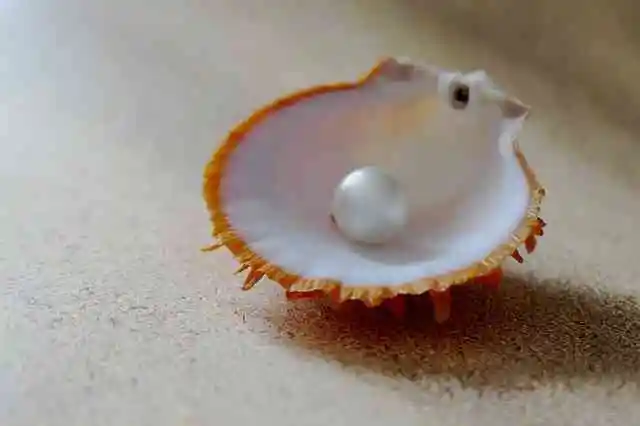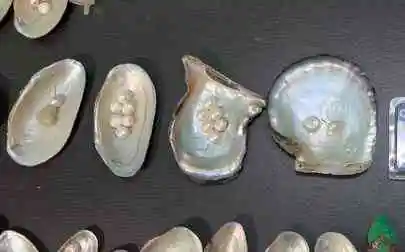Pearl farming | Big Profit in short time | ark black pearl farming
Are you someone who thinks that agriculture is limited to fields, seeds, and food production? you really need to think in a different manner. Various unconventional farming ideas are gaining popularity; One of them is pearl farming. It is one of the best aquaculture businesses in India.
From growing pearls in ponds to cement tubs to even fish tanks, a variety of methods can be used for this type of farming.
The way you can grow pearls at home in buckets or small tanks is called a recirculating aquaculture system. This system works by filtering the water in the fish tank so that it can be reused in the tank.

• In the first step of starting pearl farming, you need to test the water to understand whether it is suitable for pearl cultivation or not. Water can be tested in government laboratories. This will help determine if the mussels will survive in that water.
• A mussel, if small, can hold an average of 2-8 pearls. And if the size of the mussel is large, up to 28 pearls. After taking the mussels they are kept in the critical care unit for 4-6 days and after checking the health of the mussels they are moved to the fish tank after a minor operation to add some kind of pearl to the mussels. These oysters are kept in nylon bags for 10 days on antibiotics and natural feed.
• Once this is done, one must undergo vocational training in any institute offering pearl farming training courses. CIFA is the most prominent among them. This will help you learn the proper technique for harvesting pearls.
• The most favorable season for pearl cultivation is autumn i.e. October to December. The farmer has to collect or buy mussels/mussels from local ponds or other water bodies.
How long it will take to make a pearl?
It takes at least 6-7 months to make pearls. However, pearls usually take at least a year to grow to the proper size.
Establishment of House for Pearl Farming:
• If you are starting from home, you will need a simple setup of at least two fish tanks to get started. The tanks have to be placed one on top of the other, so that the water from the upper tank flows into the lower tank. For this you need to drill a hole in the tank placed on top.
• The tanks will be fitted with an air pump, a venturi pump, which controls the water flow and a water pump to control the water temperature.
• Once all these parts are fixed, the system should be run for seven consecutive days, for a few hours in the morning and a few hours in the evening.
• The dimensions of the tank can be as follows – 3.5 feet in length, 3 feet in width and 2 feet in depth. In a setup of this size, Jitendra says one tank can house around 60-80 mussels.
• Ensure that the algae fed to the mussels is of high quality as this will affect the quality of the pearls produced. Mussels also provide vitamins and minerals.
• For all these you get Rs. It will not cost more than 30k which is a good investment amount for such a profitable business.
• Please note: If you intend to cultivate pearls for commercial purposes, check all licensing requirements.

Pearl Farming Cost Profit Analysis: | Oyster farming profit
An oyster costs 25 to 35 rupees. A 2 mm to 25mm oyster pearl costs around Rs 400 to Rs 2000 in the market. These days designer beads are highly preferred which fetch good prices in the market. Much better money can be earned by exporting pearls abroad than in the Indian market.
After removing the pearl from the mussel, the mussel can also be sold in the market. Many decorative items are made from oysters. Extraction of aromatic oil from oysters is also carried on on a large scale in Kannauj. So the mussels can be sold immediately in the local market as well. The water of rivers and lakes is also purified by oysters so that the problem of water pollution can be dealt with to a large extent.
Varieties of pearls
• Natural pearls
• Cultured freshwater pearls or cultured freshwater pearls
• Hair pearls
• Seawater conservation pearls (salt water)
• Japanese cultured pearls
• Cultured Pearl and Mabe Pearl
Points to keep in mind before you start a pearl farming business
Of course, like any other business, the pearl farming business requires your time, effort, interest, some investment and most importantly, patience. You have to wait about 1-4 years for the first harvest.
Points to remember.
• To create pearls, you must have enough space
• Knowledge of grafting techniques is essential before starting a business.
• Contact market retailers to sell your pearls.

Freshwater pearl method
It depends on the internal structure of the shell and the type of Perl. The entire process of cultivating freshwater pearls requires modern surgical skills to complete the cultivation, as opposed to sea pearls. Pearl quality is assessed using a pearl grading system based on the surface of the freshwater pearl, its size, luster and the appropriate color it produces. This requires assistance in the production of pearls, which are easier and cheaper to cultivate than other pearls, thus driving up the price of freshwater pearls.
This is the process of growing freshwater cultured pearls in farms. Over a period of 3-6 years, pearl farmers breed and care for thousands of oysters and produce pearls. It takes both skill and luck to land it. Pearl farming can be subject to uncontrollable and unpredictable forces, such as severe storms, water pollution, disease, extreme cold or heat, infection, etc.
Before you start cultivating pearls, you need to get oysters to nucleate. In the past, this meant fishing for oysters in the sea. Today, pearl growers find it easier and more productive to grow their own. All farmers want to do is collect oyster eggs and high-quality oysters that are already present in the field.
Growing oysters for freshwater pearl farming
Oyster larvae are kept under controlled conditions. they are freely swimmers in the water. After they are a few weeks old, they are transferred to the “wild”. Over the next few months, the larvae will grow into baby oysters. It is finally sent to the Collector for collection. They are then transferred to a separate section of the farm which is used as a “nursery” for the young.
There, baby oysters are nurtured for 1-2 years until they are ready for nucleation based on the size and development of freshwater pearls. Enucleation is a surgical procedure. A foreign object is placed inside the oyster causing it to become irritated. It produces real pearls, which are similar in size to freshwater pearls and freshwater pearls.
Cultured pearls – They are produced under controlled conditions by mussel and oyster breeders using two different groups of mussels, freshwater and river mussels, and saltwater pearl shells.

A step-by-step process for commercial pearl farming
Site selection
This is an important first step toward creating a good pearl. The site affects how well the pearls grow, the quality of the pearls, how safe the farm is from theft or vandalism, and how much it costs to run the farm. Moreover, it is difficult to transfer the form after installation.
Farms were established
A pearl farm requires only a very simple structure. Farm structures in pearl farming are Tahitian or Tahitian longlines, rafts and underwater trestles. You can also use some combination of these depending on your needs and location.
Preparation of pearl oysters
Chaplets, lantern baskets, pocket nets, and floating or submerged trays are many ways to house mature pearl oysters.
Manage the farm. Growing pearls is like growing any crop. Therefore, you should tend the farm frequently for better pearl oyster growth and high-quality pearl production. you will have to regularly monitor for any damage, floats and missing lines. You clean the pearl oysters from the contaminating organisms that grow on their shells. Always handle pearl oysters gently when cleaning.
Grafting of pearl oysters
The ideal pearl oyster size for grafting is about 13-18 cm(5-7 inches) in length. You can graft older and larger pearls but the chances of producing high-quality pearls are low. Also, you should clean the pearl shell magazine before grafting. Cleaning keeps pearl oysters healthy and in good condition.
Harvest Pearls
Pearls should be harvested when the nacre layer is 0.5-1 inches thick. Don’t risk making pearls with a thin comb when trying to harvest early. Store pearls in a safe place after harvesting. Wash the pearls after harvesting. Finally, keep a record of every transplant and harvest in your pearl farming business.
Pearl farming Proft per acre – Calculation | pearl farming profit
Pearl farming makes you rich in no time: Rs. per month with a 50% government subsidy. Earn 400,000
This is pearl farming. To start this business, you don’t need to spend a lot of money. Initially Rs. 35,000-40,000 is required. The government is giving a 50% subsidy and you can easily earn 400,000 in a month. In recent times, people’s interest in pearl cultivation has increased rapidly.
Earn Rs. 400,000 by investing 40,000 – Two pearls come out of an oyster. A good quality pearl sells for more than Rs 250 while a plain pearl sells for at least Rs 130. A mussel is made for 30 to 40 rupees. In such a case, putting 28,000 shells in a one-acre pond costs about Rs.6 to 700,000. If 40% of the oysters are Considered Mortality in the process of production, an annual income of Rs 30-35 lakhs can easily be achieved.
You can also start oyster farming from Rs 40,000 which can earn you Rs 400,000 per year. However, this does not include the cost of digging the pond, as it is done only once and also gets a 50% subsidy from the government. A few farmers have started pearl cultivation, earning an annual income of Rs 800,000 to 10,00000 lac per year
You Can read this too